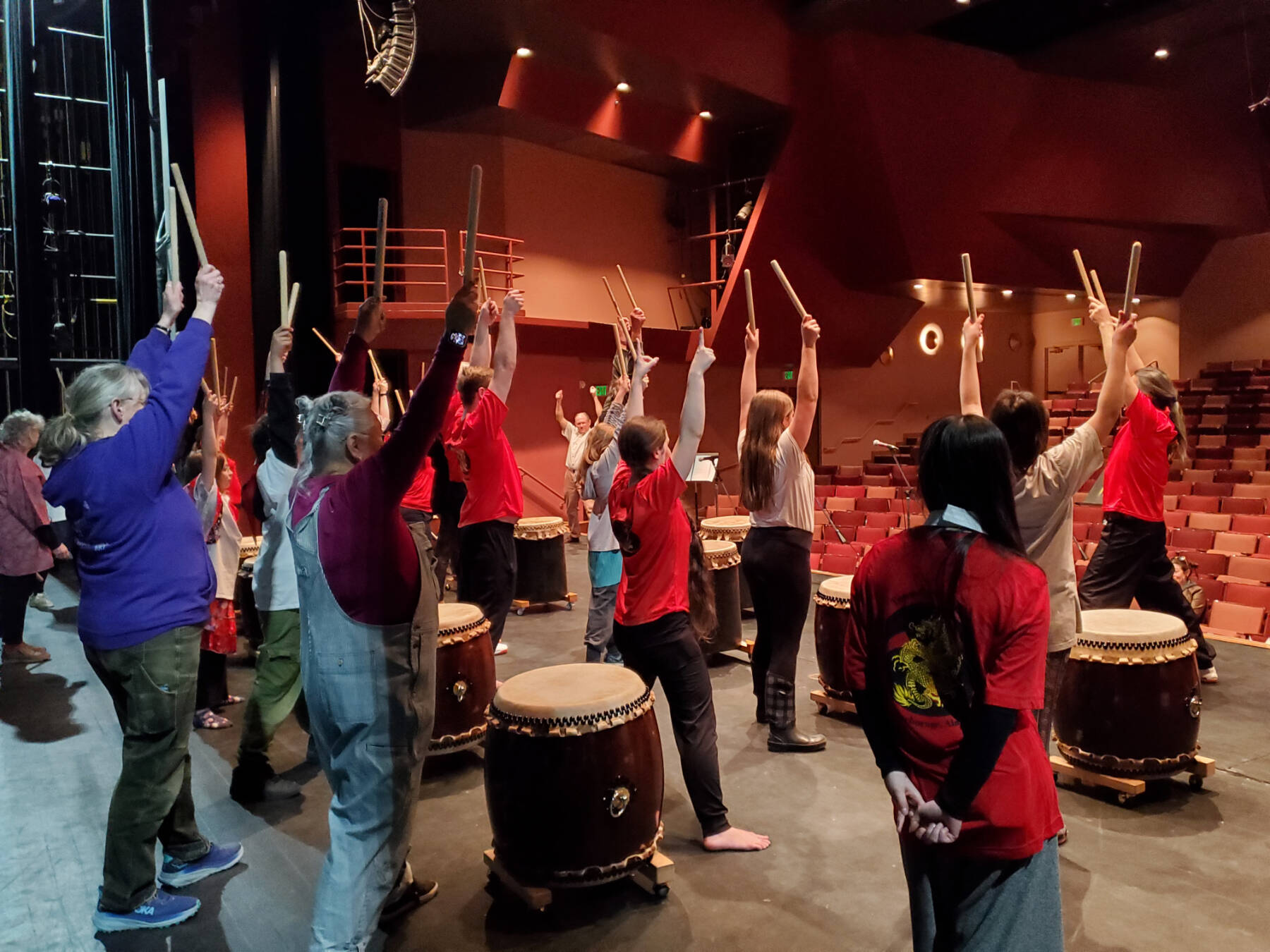Homer was treated to an immersive Japanese traditional drum experience last weekend as part of the city celebrating their 40th anniversary with their sister city, Teshio, in Hokkaido, Japan.
Anchorage-based Tomodachi Daiko, Inc. held an intensive taiko drum-building workshop at Kachemak Bay Campus on Friday, May 3, followed by three taiko ensemble performances on Saturday, May 4 in Homer High School’s Mariner Theatre. The free shows were held at 11 a.m., 1 p.m. and 4:30 p.m.
An additional workshop for community members and Homer’s Alaska Japanese Club was held from 2:30-4 p.m. in the Mariner Theatre — this time to teach drum-playing, rather than drum-building. Participants in Saturday’s workshop also took part in Tomodachi Daiko’s final performance at 4:30 p.m.
“Tomodachi” translates to “friend” — the meaning behind Tomodachi Daiko’s name, then, can be either “friends of taiko drumming” or “making friends through taiko.”
“Our mission through taiko drumming is to make friends,” Tomodachi Daiko founder Sachiko Kono told Homer News on Saturday. “The most important thing is having fun — for both the drummers and the audience.”
Cathy Stingley, longtime Homer resident and president of the Pier One Theatre board of directors, recently returned from a visit to Teshio with her granddaughter and granddaughter’s friend. She gave introductory comments at Saturday’s performances, thanking the City of Homer, including assistant to the city manager Lori Pond and Homer Public Library director Dave Berry, for sponsoring the sister city celebrations.
Megumi Beams, sister city liaison/interpreter and Japanese international exchange coordinator and instructor, led students in Homer’s Alaska Japanese Club in singing a Japanese graduation song, “Believe,” at the start of each show.
Tomodachi Daiko played a wide repertoire of songs across all three of their scheduled performances, bringing a little something different to each show. Jacki Holzman, who began playing taiko and has been involved with Tomodachi Daiko since 2004, served as the emcee during the show and explained the significance or background of each song.
The ensemble used a variety of instruments in their performances, including several nagado daiko drums, which are the typical or most popular form of taiko drum which Tomodachi uses to perform the melody of each piece; three shime daiko, which are smaller Japanese drums that have a higher pitch than the nagado daiko; shinobue, which is a Japanese side-blown bamboo flute; and kane, which is a Japanese dish-shaped brass bell.
“We’ve got five different instruments, and then we have our voice, and then we have our bodies, which we also consider instruments,” Holzman said.
The ensemble began the first show with a song titled “Yamano Ohayashi,” which is a “celebration of our mountains, and also the mountains in Japan,” Holzman said.
“We have so much in common that we celebrate,” she said.
Second came a piece in three parts called “Alaska Hiryu.” Holzman said that, for this second song, audience members should imagine dragons “flying off over our lovely Alaskan mountains.”
According to Holzman, the third song, “Hanagattami,” was played in feudal Japan to send samurai out to battle.
“So this is our battle cry,” she said.
The fourth song, “Alaska Nokokoro” — meaning “the heart of Alaska” — was written specifically for Tomodachi Daiko by Dengakuza, a professional taiko group from Japan’s Nagano prefecture, for a joint concert performed by the two groups in Anchorage in the summer of 2023.
“We were so honored to have Dengakuza come and share a stage with us, and then to compose a song for us,” Holzman said.
“Alaska Nokokoro” is played in four parts, with one representing the earth, one for the oceans, one representing the mountains and the final part representing the sky.
The final song in Tomodachi Daiko’s first performance was called “Buchi Awase Daiko,” which Holzman said is one of the most popular songs in Japan.
“Japan is made up of hundreds and hundreds of islands, and every single island has their own taiko, their own particular, unique style,” Holzman said. “Which means that everybody thinks they’re the best. So the story goes that the losing taiko group has to take the skins off their taiko and throw them into the ocean…. We hope you will let us keep our taiko.”
For more information on Tomodachi Daiko, visit www.tomodachidaiko.org/.


